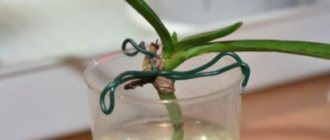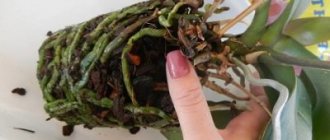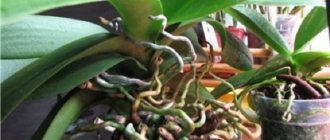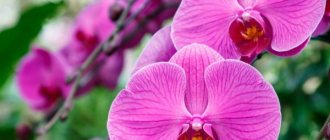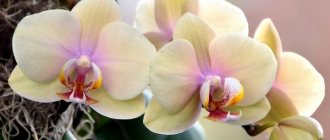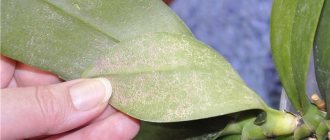The peduncle, or arrow, of phalaenopsis is a shoot that extends upward from the base of the plant, forming a tall curved spike.
It is on it that flowers will subsequently grow (hence, in fact, the name).
At the initial stage of development of the phalaenopsis peduncle, an inexperienced gardener may confuse the peduncle with the root or even the baby of the orchid
. How can you understand that this is a flowering shoot?
The main difference between the arrow and any part of the plant: even on a very young peduncle you can notice irregularities that look like small thorns or scales - these are dormant buds. The peduncle is the most important part of the orchid, figuratively speaking, the heart of the plant
.
The peduncle provides all the beauty of the plant, since flowers are formed from the buds on it, and in addition, on the peduncle of each phalaenopsis there is a growing tip, and as long as it is alive and green, you can always count on the fact that it will continue to produce more and more new buds .
How to distinguish a peduncle from a root?
The period of growth of the peduncle is of great importance, because how you care for the plant at this time determines whether your phalaenopsis will please you with flowers, or whether you will only admire its foliage.
Growth characteristics
In ordinary phalaenopsis, the peduncle is formed on average in two months, in hybrid phalaenopsis - in three.
This time includes the period immediately from the moment the stem appears to the already formed peduncle.
Variations in how quickly the arrow grows are possible depending on the conditions.
If the owner provides his green friend with the necessary lighting, a sufficiently humid environment and a temperature comfortable for shoot development (from 25 degrees), the process will speed up by 1.5-2 times.
The development of the lateral peduncle occurs somewhat faster - in a month and a half.
We talked more about exactly when phalaenopsis blooms and how long this period lasts.
How many are there usually?
In Russian flower shops you can usually buy phalaenopsis with 2-3 peduncles
. There are also specimens with a large number of peduncles. In plants at home, the number of arrows released varies depending on the specific type of phalaenopsis, its state of health, and care conditions.
Step-by-step instructions on how to get a smooth escape
First of all, you need to make sure that the flower stalk on the phalaenopsis has begun to grow. How to distinguish it from the root and the baby is described above.
- When the peduncle is strong enough and grows to a length of 15-20 cm, it needs to be fixed in a vertical position.
- The arrow is tied to a support in the pot. It is most convenient to use a special clothespin for this (they are sold inexpensively in flower shops), but you can also take a simple elastic band or a crab hair clip.
- If you can’t tie the peduncle, you can simply turn the pot as the peduncle moves to the side. The arrow will be drawn towards the light and thus aligned.
Proper fastening of the peduncle for smooth shoots.
orchid peduncle
The peduncle is the part of the plant on which buds will form and, when they bloom, delight the grower.
The peduncle plays an important role in the life of an orchid.
If a flower shoot appears on the plant, then this condition can be called the active phase of plant development. At this moment, the plant must be fed with fertilizers intended for orchids. A photo of how orchids produce flower stalks can be seen above.
IMPORTANT! All fertilizers are applied only after watering, so that the velamen on the orchid’s root system does not burn.
Description
At the moment of appearance, the peduncle can be confused with other parts of the plant. A novice gardener wonders what appeared on his plant :
- Peduncle;
- Root;
- Or baby?
The peduncle begins to grow from the axil of the leaf blade . You also need to carefully examine the tip of the growing bud:
- The flower shoot will have a pointed end;
- And the roots and children are the blunter end.
And the most important thing is that the frog has a scaly coating , and the velamen on the roots has a smooth structure.
Where might it come from?
How does the peduncle of an orchid grow? We must remember that the peduncle develops from the axil of the plant leaf. Sometimes it comes out from the growth point.
All other shoots emerging from the stem and other parts (root areas) can be roots or children.
A peduncle can also appear when it blooms again from a waiting bud of an old flower shoot. It grows to the side of the main stem and does not develop many buds.
The peduncle appears from the axil of the orchid.
Sometimes the peduncle develops at a rapid pace, this indicates that the care is organized correctly . But it happens that escape:
- At first it slows down development;
- And then it completely begins to turn yellow and dry out.
This indicates that the flower is receiving little light and nutrients. On average, the development of a peduncle can take up to 3 months.
IMPORTANT! With sufficient lighting, watering and fertilizing, the shoot will form at the required pace, and the flowers blooming on it will reach their maximum size.
Favorable time for the growth of new shoots
Many beginners ask questions: when will the orchid release a peduncle and how long does it take for a new peduncle to grow?
All orchid plants begin to bloom at different times relative to their age. You cannot demand the appearance of a peduncle from a young rosette.
There are plants that bloom in the third year of life, and there are those whose age should be older.
How long does the flower stalk take to grow? It depends on the type. Some bloom all year round, regardless of the changing seasons.
Others only at certain times :
- Phalaenopsis blooms all year round with proper care;
- Cymbidium - from mid-autumn to the end of February;
- Dendrobium blooms from October to early January.
But also do not forget that everything depends on the cultivation of the orchid itself :
- If you didn't water on time, the flowers may dry out, and with them the flower shoot.
- In the absence of useful nutrients, the escape will be short.
- Also, for the development of the arrow, high humidity and good diffused sunlight are necessary.
- When buds appear, the fertilizing is removed completely , as this can greatly shorten the flowering period of the orchid.
Possible problems and their solutions
It happens that the peduncle either grows somehow “wrongly” or is completely absent.
Unfortunately, injury to the plant is also possible when the arrow breaks. For beginners, such emergency situations cause a lot of anxiety.
There's no need to panic. Let's look at each of these cases and consider what the gardener should do.
The arrow grows from the growth point - this happens with older phalaenopsis
who have survived many cycles. Another reason is severe stress experienced by the plant. This is the same case when the owner of the plant does not need to do anything. Just take care of your pet as usual. Perhaps the arrow will still produce buds or a baby.
What to do? Simply cut the peduncle to the bud closest to the fracture site, and treat the cut area with activated carbon or cinnamon powder. Under no circumstances try to connect the fragments with tape or tape, as some inexperienced amateurs try to do, in the hope that their orchid will “grow together.” This will only harm the plant; it may begin to dry out!
What should the owner of a “lazy” phalaenopsis do, how can he still grow a peduncle? If the plant is in no hurry to shoot out its arrows, you can give it a little shake-up - place it in a darker place than usual and water it less often than before (of course, without leading to complete drought). If possible, at night it is better to lower the temperature for phalaenopsis by 5-6 degrees
. Experienced gardeners make plants that have been dormant for even a year or more bloom in this way.
Stuck in development
It happens that the peduncle grows to a sufficient length and even produces several buds, and then suddenly stops its growth.
If phalaenopsis stops growing, algorithm of actions
:
- First of all, you should make sure that the orchid is healthy. Perhaps the reason is some kind of disease or pest.
- Analyze the conditions of keeping your phalaenopsis - does it have enough light, is the humidity and temperature regime observed, does it have enough feeding?
- If, after treatment and the establishment of optimal conditions, the peduncle continues to remain frozen, the most reasonable thing is to take a wait-and-see approach and watch the arrow. If it hasn’t dried out, there is a chance that your green friend will someday please you with flowers.
You can learn more about the main reasons for the lack of flowering of phalaenopsis here
What to do in case of different problems?
Grows from a growing point
It happens in a plant that has had many flowering cycles or has suffered stress (sharp change in living conditions). Provide the flower with proper care and in a short time the peduncle will delight you with flowering.
Broken
The young shoot is fragile and can break if handled carelessly. Do not try to re-grow it, but carefully cut it, powder the cut area with activated carbon or cinnamon powder. Make a cut near the nearest bud. After some time, a new shoot will form.
Not for a long time
It is very disappointing when a plant does not please us with its flowering. The following actions will help to shake it and provoke it to grow a peduncle:
- Move the pot to a dark place.
- Reduce, but do not stop, watering.
- Reduce night temperature by five degrees.
Measures to bring a flower out of hibernation should not be lengthy. A period of seven days will be sufficient.
Stopped growing
Such a nuisance occurs if the plant feels a lack of light, heat, moisture or is infected. Inspect it and change the growing conditions or treat it if necessary. In order for the flower to have enough strength to bloom, it is necessary to fertilize it with minerals or change the soil mixture.
How to distinguish from the root or other parts of the orchid?
When the phalaenopsis just begins to develop a peduncle, it can be mistaken for the root or even the baby of the plant, so you need to know how they differ from each other. It can be distinguished from the root by the following characteristics:
- it is necessary to carefully examine the place where the new growth appeared and determine its location relative to the growth point - if it grows from the stem and is located on the root collar between the leaves - this is not a peduncle, but an aerial root;
- the arrow always grows upward, while the roots are slightly inclined downward;
- the color of the roots is greenish-gray and bright green at the tips, while the arrow is monochromatic along the entire length;
- the root is smooth, and the peduncle is divided by small scales;
- the peduncles have a sharp tip, and at the roots it is rounded and blunt.
Differences between the peduncle and the basal child:
- after the baby grows a little, its tip will begin to resemble a boat shape;
- The peduncle grows only from the base of the central vein of the leaf, and the baby, as a rule, grows just above the place of the previous flowering.
We invite you to watch a video on how to distinguish a peduncle from a root in phalaenopsis:
What does it look like in the photo, and how is it different from other parts?
Young gardeners are often confused with the root of a plant. How can you tell them apart?
- Peduncles appear in the axils of the leaves. This is the angle between the plant stem and the leaf (the place where the leaf attaches to the stem). The root is formed at the base of the root collar.
- On the peduncle, even at the beginning of flowering, you can see a complex structure, scales are visible. The root is smooth and even.
- The peduncle has a pointed tip, the root is blunt and rounded.
- The peduncle is directed strictly upward, while the root most often grows downward, but can also grow sideways.
Interestingly, a hatched peduncle can easily be confused with a basal baby. They are similar in shape and place of development. Over time, the baby takes on the shape of a boat.
Let's look at what the flowering stem looks like below.
We invite you to watch a video on how to distinguish the peduncle from other parts of the orchid:
Features of care during the growth period
The period of peduncle growth is a very important moment in the life of an orchid.
when it is especially important to provide her with good care.
- It is necessary to provide the plant with good lighting.
Daylight hours for a phalaenopsis that has released a shoot should be at least 12 hours. In autumn and winter, you need to place a pot with an orchid on the window sill on the south side of the room, and if this is not possible, you should use a phytolamp for additional lighting. - Humidity needs to be maintained at an optimal level;
for this you can use a humidifier or place a container of water next to the orchid. This is especially important in winter when the indoor air is too dry. - It is imperative to feed the plant with fertilizers
that contain a lot of phosphorus and potassium from the moment the peduncle has just begun to form until the flowers appear on it. After the flowers appear, fertilizing should be stopped, as this will not increase the splendor, but may cause the flowers to drop. - Watering is carried out as usual
- as the soil dries out. The regularity is individual for each specific case, as it depends on the temperature and humidity of the air. Phalaenopsis with a regrown peduncle does not need direct spraying; it will most likely destroy the sprout. It is enough to place a flowerpot with an orchid between other plants while spraying them and it will have enough moisture.
Important!
Under no circumstances should the soil in the flowerpot be allowed to become completely dry.
Video about caring for phalaenopsis during the period of peduncle growth:
Formation period
How quickly does it form?
Let's consider how long the peduncle of an indoor phalaenopsis orchid grows. The average time for its formation in a regular phalaenopsis is two months, in a hybrid one – three. This is exactly how much time must pass after the appearance of the stem before the peduncle is fully formed. If the plant is in comfortable temperature conditions and receives the required amount of light and moisture, then this time will decrease by 1.5-2 times.
The lateral peduncle develops faster - in about 1.5 months.
How many arrows does it fire?
The most common is phalaenopsis, which has 2-3 peduncles,
but there are also specimens with a large number of flowering shoots. At home, the number of arrows depends on the type of phalaenopsis, its health and the care provided.
The number of buds in an orchid increases under extreme conditions, for example due to temperature changes, drought or an unusually large amount of light.
How to ensure growth?
How to grow a flower stalk? In order to grow it, you first need to make sure that the new growth on the phalaenopsis is actually an arrow. If this is the case, then you need to wait until it reaches a length of 15-20 cm and fix it in a vertical position, tying it to a support in a flowerpot.
It is best to use a special clothespin for this, which can be purchased at any flower shop, but you can also use a regular hair elastic or a small hair clip. If you can’t tie the peduncle to the support, you just need to rotate the pot with the orchid relative to the light.
Step-by-step instructions: what to do in a certain situation?
Let's consider what to do if the peduncle that grows from the growth point breaks or other possible cases:
- Grows from a growing point.
This happens if the phalaenopsis has already suffered a lot or has experienced severe stress. In this case, you don’t need to take any action, you just need to take care of the plant and, perhaps, buds or babies will appear on the arrow. - Broken.
In this case, you need to cut the peduncle to the bud located closest to the fracture site and treat the cut site with crushed activated carbon, wood ash or cinnamon powder.Important!
You should not try to glue or connect the fragments in any other way - this will only harm the flower.
- Absent at all
(you can find out why phalaenopsis does not bloom and how to correct the situation) by arranging a slight stressful situation for the plant. To do this, you can, for example, slightly limit the access of light to the flower or water it less often. Of course, it is impossible to bring things to a complete drought. If possible, you can lower the air temperature at night by 5-6 degrees. - Stopped growing.
To begin with, it is necessary to exclude disease or the presence of pests from the list of possible causes. After making sure that the flower is healthy, you should once again reconsider the care of the plant and make sure that it has enough nutrients and moisture, enough light, and that the temperature and humidity levels are comfortable. If the phalaenopsis is not sick and the conditions for keeping it are suitable, but the peduncle still does not grow, you can only wait - if the arrow has not dried out, the orchid can still bloom.
What to do after flowering?
What to do with the flowering shoot of an orchid depends on its condition.
- If, after the orchid blooms, the peduncle turns yellow and withers, it should be cut off at the base and the cut should be sprinkled with cinnamon powder, crushed activated carbon or wood ash.
- If only the apical bud dries out, it is better to cut the branch with it to the first lower bud.
- If the peduncle is intact, it has a green tip and dormant buds, then nothing should be done - after a while new flowers may appear on it.
Read more about how to prune Phalaenopsis after flowering.
We invite you to watch a video about what to do with the peduncle after the orchid has bloomed:
The peduncle is very important for phalaenopsis,
therefore, during the period of its growth, it is necessary to take especially careful care of the plant, and if problems arise, be able to solve them correctly.
If you find an error, please select a piece of text and press Ctrl+Enter
.
At home, orchids are bred for beautiful flowering. But sometimes this period does not come for a very long time. In addition, the emerging flower arrows can easily be confused with aerial roots or children. What does the new peduncle look like? Immediately after the formation of the flower stem, the plant needs to create optimal conditions for development and properly care for it. Then soon the flowers will bloom on the stem.
Peduncles in orchids are shoots that form from below on the above-ground part and grow upward. After the formation of a peduncle, flowers bloom on it. When the arrow just begins its formation, it is easy to confuse it with the roots or children of the epiphyte, since there are very few differences. Therefore, it is important to be able to distinguish the peduncle from the root of a phalaenopsis or its offspring.
To distinguish the peduncle of an orchid from the root and children, pay attention to the following signs:
- the roots have a rounded shape, and the flower arrows are cone-shaped;
- a flower arrow can be distinguished from a basal arrow after a while, when it grows a little, the shape of its tip becomes like a boat;
- the central vein of the leaf becomes the place of formation of the flower arrow;
- usually the arrow forms in the same place where there was flowering before;
- The main difference between the peduncle and other parts of the plant are the buds that bloom on it after final formation.
The flower stem at any stage of development is covered with irregularities in the form of scales or small spines. They are dormant buds.
It is the peduncle that is responsible for the beauty of the orchid. After all, over time, buds form and flowers bloom on it. In its upper part there is a green tip, which represents a growth point. As long as it is alive, new flowers will appear on the stem.
What is the peduncle of phalaenopsis
The long and flexible stem on which flowers form is called a peduncle. One flower branch can have from 10 to 50 buds. It is confused with children or orchid roots. If the previous stem was cut to a dormant bud, and not to the base, then in the fall this bud produces an arrow on which flowers will bloom in 1.5 months.
Where does the peduncle grow from?
The flower stem changes throughout its life. It can be old and new. The young peduncle, which emerged from the axils of the leaves, grows upward or sideways, turned towards the light, it is flat in shape with a pointed end. The branch is green in color. There are scales on the stem, it grows actively, becomes long and flexible, it is easy to break, as it is very fragile. Usually the branches are tied to a support and try not to touch them.
After flowering, the stem changes color from green to yellow or brown. Sometimes the branches turn purple or red, it all depends on the type of plant. After changing color, the flower stalks dry out and fall off. It is better to cut the stem before it is completely dry, because it takes away the strength of the plant.
How to distinguish the peduncle from the root of an orchid
At first, a young shoot cannot always be distinguished from a shoot or a root; it is not clear whether it is a root or a peduncle on an orchid. In order not to confuse the stem with other parts of the plant, they are guided by some signs. The peduncle of the orchid grows from the axil of the leaf, and next to the peduncle a baby similar to a shoot may appear.
How to distinguish a root from a peduncle or baby
| flower shoot | Roots | Babe |
| An orchid produces a peduncle from the axil of a leaf, usually in a young leaf | Grows from the outside of the neck of the orchid, may appear from the middle of the leaf | Grows next to the vein of the leaf, in the place of the flower branch, can form on the roots, on the peduncle |
| The end of the stem is pointed and has a conical stepped shape | Bright tip, light velamen | The tip looks like a beak |
| Conical shape, surface with scales | Root round, smooth | Miniature copy of an adult plant |
| The shoot itself is flattened | Kidney cone-shaped | A shoot with 2-3 leaves; small roots extend from its attachment point |
| The peduncle of phalaenopsis grows upward, sometimes to the side | Directed downwards, but aerial roots can grow sideways and upwards | Reaching up |
It is impossible to distinguish the peduncle from the root of a phalaenopsis or baby at the beginning of growth. It will be possible to determine by the shape of the tip over time, when the shoot is at least 4 cm. The peduncle, baby or root differs - dormant buds in the form of scales on the arrow.
Care before the appearance of the peduncle of the orchid and during the growth period
Until an arrow appears on the epiphyte, cultivation is carried out according to standard rules. The flower is provided with diffused lighting. To do this, it is moved from the southern window sill in mid-spring. Water the plant so that the soil dries out for several days between irrigations. This will enable the root system to take part in the process of photosynthesis.
The plant is provided with an influx of fresh air and at the same time protected from drafts. Cold is especially dangerous for orchids in winter. Damaged parts cannot be healed. Therefore, frozen tissues are cut out. Air humidity in the room is maintained at least 65%. During this period, the flower is regularly fed with special fertilizers marked “For orchids.” Others are not suitable for epiphytes because they burn the root system.
During the formation of the flower arrow, the care of the epiphyte changes. Therefore, it is important to know how to care for an orchid when it has released a peduncle.
After the orchid has a peduncle, irrigation is reduced. But at the same time, the flower is not subjected to overdrying. To do this, increase the interval between watering for drying to 5 days instead of 2-3 under the usual cultivation regime. Then the orchid is watered not once a week, but twice a month.
While the orchid’s peduncle is growing, the addition of nutrients is reduced. Fertilizing is completely abandoned when the plant begins to form buds. If this is not done, flowering will be short.
If the orchid has put out an arrow in the fall or winter, the pot is moved to the south side. If this is not possible, additional lighting will be provided. Otherwise, the shoot will stop developing. For good development, the arrows maintain the air temperature in the room from +23 to +26 degrees. Lower temperatures reduce the growth rate and cause the arrow to dry out.
The number, size and color of the buds largely depend on how carefully the plant was cared for in the last 120 days before the formation of the stem. If fertilizing is applied only at the moment the peduncle appears, there will be no abundant flowering.
Phalaenopsis has a peduncle growing from its growing point
No, it won’t die, but it won’t bring you new blooms anytime soon!
Under normal conditions, the peduncle of an orchid appears from the axil of the leaf. However, you can often buy an orchid on sale whose peduncle is located exactly at the growing point. These are the so-called instant-forcing or myriclonized orchids.
It is this rosette that will no longer grow after flowering, but it will begin to form children. Babies may appear from under the lower leaves or on the peduncle itself. All we have to do is wait for the children to grow up and bloom.
In rare cases, it happens that the plant forms a new growth point from the axils of the upper ones and begins to grow sideways.
The mother plant with a peduncle from the center of the rosette can produce repeated flowering, but in this case it will give birth to children later. Therefore, it is better to prune it before the end of the first flowering. Pruning is carried out above 2-3 buds, the cut is powdered with ground cinnamon, charcoal powder or treated with brilliant green. Reduce watering to once every 10-12 days.
Between waterings, it is necessary to fertilize the leaves with nitrogen-containing fertilizers.
For the first month, such feeding is alternated with spraying with water with the addition of Zircon or Ribav Extra.
It is also useful to sometimes give the orchid a shower with warm water (40-45 degrees) for 1-2 minutes.
With this care, babies appear in 3-5 months. They are not separated from the mother plant for quite a long time (up to several years) until they grow and become stronger.
If the baby appears on a peduncle, you need to wait until its leaves reach a length of 2-3 cm, then wrap the base of the baby with sphagnum and periodically moisten it with water. This way the baby forms roots faster. When the roots reach a length of about 5 cm, the baby can be separated.
Phalaenopsis quickly gained popularity among indoor plant lovers thanks to its unusual flowers collected in an exquisite inflorescence. This type of orchid is quite easy to care for , and flowering can last from several weeks to several months.
The plant needs special attention during the formation of the peduncle and after the flowers have fallen off.
If simple requirements are met, this flower will delight you with regular, lush blooms.
This article contains everything about phalaenopsis flower stalks: pruning, rooting and other issues.
Peduncle of phalaenopsis
The peduncle of phalaenopsis is a fairly high arrow, at the top of which an inflorescence is formed - a raceme .
The peak formation of flowering arrows occurs in early autumn . At this time, night temperatures begin to differ significantly from daytime ones.
https://www.youtube.com/watch?v=WIaaycTBApI
It usually appears from under the leaf in the form of a small greenish cone. During this period, the flower shoot is easily confused with the developing root, which has a more rounded shape.
Only when the length of the hatched bud is more than 1 cm can you say for sure what kind of shoot it will be - vegetative or flowering.
During the formation of the flower-bearing arrow, phalaenopsis needs special attention:
- At this time, it is better to place the orchid in the brightest place in the room; in the fall it can be a south window;
- The watering regime should be regular as the soil dries out;
- If you fed the orchid before the arrow formed, then this can be continued until the first flower appears.
- the shoot with opening buds is sensitive to air flows from an air conditioner or radiator . If an orchid is left in a draft, it can lose all its buds in one day;
- During the flowering period, phalaenopsis should not be replanted. It is better to place the pot in a decorative transparent flowerpot that matches your interior;
- you can use a special plastic support for support
- At this time, the plant should not be moved to another place or rotated. With a lack of natural light, the arrow will stretch out and the flowers will be faded. In autumn, it is better to install artificial lighting, lengthening the daylight hours to 10-12 hours.
Read also: Treatment of walnut partitions with tincture reviews
Orchids attached to a support.
When growing orchids, beginning gardeners often have questions, the answers to which will help solve a number of problems.
Growing from a cut peduncle
When propagating phalaenopsis from a flowering shoot, the standard cutting method is used. This is done during the period when the plant has faded, but the peduncle remains green and has dormant buds.
So, how to grow phalaenopsis from a cut peduncle:
- before starting work, the pruning shears are treated with alcohol;
- the flowering arrow must be cut to the very base of the rosette and cut into pieces of 3-4 cm. There should be a dormant bud in the center of each cutting;
- the resulting sections are sprinkled with crushed activated carbon;
- cuttings are germinated in a mini-greenhouse filled with damp sphagnum moss at a temperature of +26-28℃.
A humid and warm environment will provide conditions for the rapid formation of babies on cuttings.
According to another method, cut cuttings are placed in water into which mineral fertilizer has previously been added. The container must be placed in diffused sunlight. In about a month, little babies will appear on the cuttings.
Cuttings can also be germinated in a bottle.
Side arrow
A peduncle on a peduncle (lateral flower arrow) may form on a green peduncle several months after the flowers have completely fallen off. After some time, buds will form on it and it will bloom.
To stimulate this process, the green peduncle is cut at a distance of 1 cm above the dormant bud. The closer to the base of the rosette there is a bud above which pruning is done, the more flowers are formed on the side shoot.
Pruning after flowering
Answer to the question “Do I need to trim the peduncle after flowering?” depends on the type of phalaenopsis and how the flowering shoot behaves after flowering:
- changes color, turns yellow and dries;
- partial drying of the flower-bearing arrow is possible;
- The peduncle remains green.
dry, darkened arrows . This is done only after the flowering shoot has completely dried. From the fading peduncle, the plant receives nutrients that have accumulated during flowering. They are necessary for the plant for further recovery and growth.
The dried flowering shoot is cut at a height of about 2 cm from the base of the rosette. After a few months, under optimal conditions, the orchid will form a new arrow.
Read also Buy fertilizers for nymphs
When partially dry, only the dry part of the flowering shoot is removed. It is better not to cut the green peduncle, as after a while it may bloom again.
Stimulating pruning of green flowering shoots can be done in the spring. To do this, it is cut 2-2.5 cm above the dormant bud. This can push the orchid to form a baby.
From the point of growth
The appearance of a peduncle from the growth point means that the phalaenopsis has stopped growing in height and will no longer be able to grow leaves.
Now, in place of the socket, children will form . They can appear from dormant buds in the axils of the lower leaves or on the peduncle itself.
Thus, if the peduncle grows from the growth point, then all that remains is to wait until the children grow a little and I am ready to transplant.
Peduncle from a growing point.
Stimulation of growth
We must remember that in order for a plant to produce a flowering arrow, it needs to create optimal temperature conditions, lighting and care.
If the flower stalk still does not form, there are two simple ways to force the flower stalk to release and bloom profusely:
- reduce as much as possible and sometimes completely stop watering the orchid after flowering;
- create conditions for daily temperature fluctuations from +22-24℃ during the day to 16-18℃ at night.
In the autumn, daylight hours are extended to 12 hours with the help of artificial lighting.
Quantity
Peduncles of orchids are formed from dormant buds in the axils of the leaves. From 1 to 4 flower-bearing arrows can bloom simultaneously on one plant . The main condition on which the number of peduncles in phalaenopsis depends is the species.
Short peduncle
There may be several reasons why the flowering shoot of phalaenopsis grows short
- perhaps this is a specially bred hybrid form;
- after purchase in the store, the growing conditions changed, which affected the development of the unformed peduncle;
- phalaenopsis produces a short peduncle in summer, and a longer one in winter;
- if several flower-bearing arrows have formed;
- from lack of nutrients.
Hybrid phalaenopsis with a short peduncle.
Proper care and growing conditions will guarantee the well-being and lush flowering of the plant.
How to trim correctly?
Phalaenopsis pruning is best done with garden pruners . It injures the plant less than a knife or scissors. Before use, instruments are disinfected with alcohol or immersed in boiling water for several minutes . This will avoid infection and plant disease.
Stopped growing
In some cases, the flower stalk stops growing. If the peduncle has stopped growing, there may be several reasons for this:
- insufficient lighting , sometimes just prolonged cloudy weather. It is better to move such an orchid to a brighter window;
- Phalaenopsis roots have rotted . In this case, phalaenopsis needs to be transplanted;
- sometimes the growth retardation of flowering shoots is due to insufficient watering . Orchid lovers advise covering the surface of the pot with sphagnum moss. This will provide additional moisture and change the acidity of the substrate, after which the peduncle can begin to grow again.
Thus, stopping the growth of the flower-bearing arrow is usually associated with improper care of the plant.
Read also: Grow pomegranates in the middle zone
Growth period
The period of how long the peduncle grows in phalaenopsis, from the appearance of the shoot to the blooming of the first flowers, usually lasts about two months.
Useful videos
The video below shows how the peduncle grows: In this video you can see how to secure the peduncle of an orchid:
-review of various fasteners for phalaenopsis: Watch the video on how to trim an orchid peduncle:
Source: https://bymosque.ru/u-falenopsisa-iz-tochki-rosta-vyros-cvetonos/
Growth Characteristics
In ordinary phalaenopsis, the peduncle grows for 2 months. Hybrid varieties produce flower stalks longer. Their formation period takes 3 months. During this time, the newly hatched stem turns into a full-fledged arrow. Depending on the growth conditions of the Phalaenopsis orchid, the interval may increase or decrease.
When provided with the right amount of light, sufficient humidity, warmth and nutrients, the growth process is 2 times faster. The side stems grow even faster and are fully formed in 1.5 months.
Typically, an orchid produces 2 to 3 flower stems. Sometimes in florist shops you can find plants with a lot of arrows. At home, the number of flower stalks is determined by the growing conditions of the plant and its care.
After the orchid shoots, it is important that it grows evenly and looks beautiful during flowering. To do this, perform the following steps:
- When the arrow grows to a length of 20 cm and is strong, it is fixed vertically.
- An orchid with a peduncle must be tied to a support using a special clothespin. If you don’t have one, use a regular hair tie or crab clips.
- If it is impossible to tie the flower stem, the pot is regularly unfolded as the arrow develops. Then it will reach out to the light and grow in the right direction.
Step-by-step instructions: how to grow?
You can make sure that this is definitely a peduncle stalk when it grows to 10 cm and takes shape. After this, fix it in a vertical position and continue to care, following the recommendations given earlier. This is necessary to obtain an even and beautiful stem. It is recommended to fix the peduncle in the following ways:
- Secure it to a support placed in a pot. Using a special clothespin, purchased in a store or made from fishing line, or a hair elastic.
- Without support. The peduncle reaches towards the light source. Rotate the container with the plant, thereby setting the direction of growth.
Video on how to secure an orchid peduncle:
How to prevent a stop in the development of the arrow
When a flower stalk appears on the plant, it is important to create comfortable conditions. Then the arrow will constantly develop and will not stop developing. To do this, it is important to ensure that the lighting does not decrease. If the length of daylight hours has decreased, additional illumination with phyto-paws is organized.
Waterings are gradually reduced and the interval between them is increased. It is important not to overdry the plant. The temperature in the room is maintained at the optimal level for good growing season. Fertilizers are applied on time in accordance with the attached instructions.
How to make phalaenopsis shoot arrows at the same time
Usually an orchid produces only one arrow on which flowers form. You can grow several flower stalks only on an adult plant that has from 8 to 10 leaves in a rosette. Such an orchid often produces 2-3 flower stems, but it is not capable of throwing out more than three.
By expelling several flower arrows, the plant is stressed. Then, after abundant flowering, the orchid will begin to hurt, and it will develop a loss of strength. Therefore, experienced gardeners do not advise artificially stimulating the plant to form more than two stems.
Possible problems
Sometimes the peduncle of an epiphyte does not grow for a long time or the arrow has grown incorrectly. Often, flower growers with little experience break the flower stem. In this case, you need to understand the cause of the problem and determine actions to solve it.
If the arrow grows from its growth point
This problem arises when growing older phalaenopsis that have already bloomed many times. Another reason is severe stress. After all, orchids are sensitive to conditions. The owner needs to learn that this situation does not require correction. This plant is provided with normal care. Perhaps in a short time new flower stalks or children will appear on it.
If the flowering stem breaks off
To correct this situation, the stem is cut slightly above the nearest healthy bud. The open area is treated with activated carbon powder or ground cinnamon to prevent infection from entering the open tissue.
Do not tie the piece to the remaining part. It will still not be possible to connect them; you can only worsen the condition of the flower. Better take good care of the plant, then it will bloom again.
Lack of flowering stem
It is not always possible to grow phalaenopsis so that a flowering stem forms on it. Then the flower is given a “shake” to speed up this process. To do this, move the pot to a darker room. At the same time, the amount of irrigation is reduced, but the substrate is not completely dry. If possible, reduce the room temperature by 5 degrees at night. In this way, it is possible to awaken phalaenopsis that have been hibernating for a year or more.
Stopped development
Sometimes an orchid's peduncle has grown to a sufficient length and formed several buds, and then further growth stops. Then the following steps are taken to improve your health:
- Carefully inspect the epiphyte to make sure there are no diseases or infestations by insect pests.
- If everything is in order, they analyze the conditions under which the flower is kept. It should have enough lighting and nutrients, heat and air humidity.
- If, after changing the growing conditions, the flower stem still does not resume its growth, the most reasonable solution is to monitor the plant. After some time, the not withered arrow will definitely begin to grow and delight you with flowering.
Actions after flowering is completed
When the flowering period ends, caring for the flower depends on the condition of the flower stem. If the shoot turns yellow and shows signs of drying, it is cut off at the very base. The resulting wound is sprinkled with crushed charcoal or ground cinnamon to prevent infection. You can use chalk for the same purpose.
When the stem itself is green and the apical bud has dried up, the stem is shortened. The cut is made slightly above the first living bud. Exposed fabrics are treated with cinnamon, charcoal or chalk for disinfection.
If there are no signs of wilting or drying on the stem, it stands green, with healthy buds. After the end of the dormant period, buds will again form on such a stem and flowers will bloom. Therefore, you don't need to do anything with it.
Why did the orchid release the central peduncle?
- Orchid - “old lady”. The flower is many years old, it is exhausted. The peduncle is the last thing a plant can please. Or surprise you with a baby. What would be the best development for the orchid?
- The environment has changed.
The lighting is poor or the orchid is in the cold or, conversely, in a dry room. - She was stressed. Due to any other reasons. And I decided that I needed to decide something, to be fruitful, for example.
Peduncle from the growing point
There is no need to do anything supernatural with such a “desperate” orchid. Take care as usual. In order for your exotic to give birth to a baby as quickly as possible, create the necessary conditions for her. And don't despair!
Phalaenopsis can lose a growing point in several ways:
- The most common way to lose a growing point is if a peduncle grows out of it. The reason for this may be the age of the flower or the characteristics of its variety. According to collectors, the following popular varieties suffer from peduncle from the growing point: perfume factory, wild cat, equestris and others.
- Also, the growth point of a phalaenopsis can be lost if it is frozen or due to rot. The good surgeon in me probably died, because I try to carefully cut out rot of any etiology with a stationery knife.
- The third way to lose a growth point is mechanical. This happens when the orchid falls unsuccessfully. This can happen if you have tailed friends who are vying for vacant places on the windowsill. Also, the stump may remain after the orchid is rejuvenated.
However, do not despair, because if there are healthy roots and dormant buds on the neck - the so-called meristems, at least one basal children may appear on the neck.
A little theory
“The meristem is the bud on the neck of the phalaenopsis between the leaves, from which flower stalks or children appear.”

